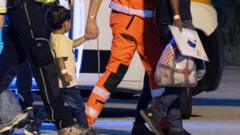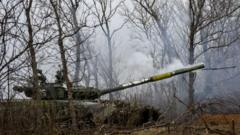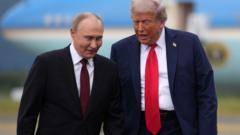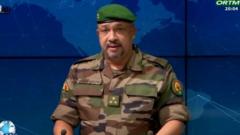The proliferation of fibre optic drones is heightening tensions in the Ukraine war, dramatically altering battle tactics and posing new risks for Ukrainian soldiers.**
New Drones Shift Dynamics in Ukraine War**
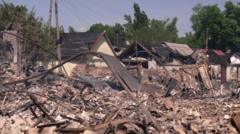
New Drones Shift Dynamics in Ukraine War**
Fresh advancements in drone technology are proving to be a game-changer in the ongoing Ukraine conflict, as Russian forces intensify their attacks.**
In the eastern Ukrainian town of Rodynske, the aftermath of recent Russian airstrikes is palpable—the air thick with the acrid smell of destruction, a stark reminder of another day in the chaos of war. Just a day after a 250kg glide bomb devastated the local administrative building and took down several residential blocks, the town is left in ruins. Russian forces continue to tighten their grip on the Donetsk region, attempting to encircle towns like Rodynske as part of a larger strategy to control critical supply routes.
Amidst the rubble, artillery fire and the droning sound of Russian UAVs indicate an intensified focus on drone warfare. As our reporting team observes, the sky is filled with drones—a testament to the evolving combat tactics that are reshaping the battlefield. Soldiers in these frontline areas are increasingly anxious as proximity to enemy drones poses a more immediate threat than conventional artillery. The situation is dire, with Ukrainian forces engaged in efforts to repulse the invasion despite waning resources.
The emergence of fibre optic drones, equipped with extensive control cables that prevent electronic interference, has caught Ukrainian forces off-guard. Unlike traditional drones, these fiber optic models can operate covertly, thus evading military countermeasures once effective in neutralizing aerial threats. This development is being leveraged by Russia, which began deploying these drones before Ukraine could adequately counter the threat.
Reflecting on the new reality of warfare, soldiers share harrowing accounts of life on the front lines. Those in the trenches are now spending extended periods in harsh conditions, often exceeding 30 days without rotation, as the threat of being targeted by enemy drones looms ever greater. The tactics of Russian infantry have also adapted, often opting for raids by small units using vehicles like motorcycles to navigate around Ukrainian defenses.
The psychological toll of this conflict remains evident—personal sacrifices weigh heavily on the hearts of the soldiers. Many have families, with young children they long to see, yet they persist in their duty, fueled by a steadfast commitment to defend their nation, even as mounting challenges complicate their efforts.
As the war shows no sign of abating, the urgent need for weapons and logistical support continues to be a focal point for Ukrainian forces. The shift in battle dynamics brought on by drone warfare poses a critical challenge that both sides must navigate in this evolving conflict, as they vie for control in one of the most consequential wars of our time.
Amidst the rubble, artillery fire and the droning sound of Russian UAVs indicate an intensified focus on drone warfare. As our reporting team observes, the sky is filled with drones—a testament to the evolving combat tactics that are reshaping the battlefield. Soldiers in these frontline areas are increasingly anxious as proximity to enemy drones poses a more immediate threat than conventional artillery. The situation is dire, with Ukrainian forces engaged in efforts to repulse the invasion despite waning resources.
The emergence of fibre optic drones, equipped with extensive control cables that prevent electronic interference, has caught Ukrainian forces off-guard. Unlike traditional drones, these fiber optic models can operate covertly, thus evading military countermeasures once effective in neutralizing aerial threats. This development is being leveraged by Russia, which began deploying these drones before Ukraine could adequately counter the threat.
Reflecting on the new reality of warfare, soldiers share harrowing accounts of life on the front lines. Those in the trenches are now spending extended periods in harsh conditions, often exceeding 30 days without rotation, as the threat of being targeted by enemy drones looms ever greater. The tactics of Russian infantry have also adapted, often opting for raids by small units using vehicles like motorcycles to navigate around Ukrainian defenses.
The psychological toll of this conflict remains evident—personal sacrifices weigh heavily on the hearts of the soldiers. Many have families, with young children they long to see, yet they persist in their duty, fueled by a steadfast commitment to defend their nation, even as mounting challenges complicate their efforts.
As the war shows no sign of abating, the urgent need for weapons and logistical support continues to be a focal point for Ukrainian forces. The shift in battle dynamics brought on by drone warfare poses a critical challenge that both sides must navigate in this evolving conflict, as they vie for control in one of the most consequential wars of our time.




